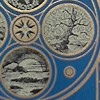



|
|
|
Title | The Time Machine & The Island of Doctor Moreau
| |
Series | ---
| |
Author | H.G. Wells
| |
Illustrator | Grahame Baker
| |
Publisher | Folio Society - 2004
| |
First Printing | 1895
| |
Category | Science Fiction
| |
Warnings | None
| |
Main Characters
|
The Time Traveller, Edward Prendick, Dr. Moreau, Montgomery
| |
Main Elements | Time Travel
|
|

The Time Machine (1895) and The Island of Doctor Moreau (1896) brought H.G. Wells instant fame and established him as one of the pre-eminent founders of modern science fiction. Even at their most bleakly pessimistic and ironic, these stories testify to the resources of human courage and ingenuity.
(The Time Machine is based on the revised 1924 edition. The Island of Doctor Moreau is based on the first (1896) edition with minor emendations. Printed on Caxton Wove paper by Memminger MedienCentrum and bound by Real Lachenmaier in full library buckram blocked with a design by the artist.)

Earlier this year I had read The War of the Worlds and found it to be downright shocking, more terrifying than most post-apocalyptic books we read these days, the utter despair of being completely helpless before a superior foe and only surviving...well I was going to say luck but really, it was science. And oddly, at no time did it feel dated, I could easily picture the same thing happening now, just bumping up the tech on both sides a bit (the Tom Cruise movie does exactly this, where the tripods could shrug off even an nuclear bomb).
Thus I started on The Time Machine eagerly. However, I guess I've read too much Lovecraft recently, I've seen plenty of variations on decadent ruins and white apes, the only thing that made this one different was that it took place in the future instead of some remote location in the present. Of course Wells wrote his book first, but I just happened to have read Lovecraft first, and while of course the styles are different, the overall story could have come from either of them. It was also a bit random at times, like somehow the narrator knows the white apes are called Morlocks though how he finds this out is unclear. He also theorizes about how this state of affairs comes to be, and admits at time to being wrong, but in the end, he never has any proof of what really happened. Maybe the Morlocks are from Venus, and not an evolutionary descedant of humans? All kinds of things could have happened between then and now.
This book also contains The Island of Doctor Moreau. In fact, before I started reading I was flipping through the book and was all confused about the page headings, I thought maybe they put the wrong cover on the book! In fact this second "surprise" inclusion is nearly twice as long as the titular The Time Machine. And I'm not sure the length did it justice. Personally I found it hard to believe that vivisection (disection and grafting) could create the creatures on the island, particularly their sudden ability to understand and speak English. A modern day retelling with modern genetic technology would be far more convincing. The quasi-religion the creatures have was interesting though. But of course back when it was written it would have worked, and would have been quite in line with Frankenstein. Again, I didn't enjoy this tale as much as I'd expected to, yes, it was dark and disturbing, a gothic horror as intended, but feels dated to a modern reader.
But to be fair, these are some of the earliest science fiction tales out there, while much older ones could be argued, these are the real classics, the ones that set the stage for future authors. The alien invasion, time travel, manipulation of living forms, key elements of SF that was to come.
|